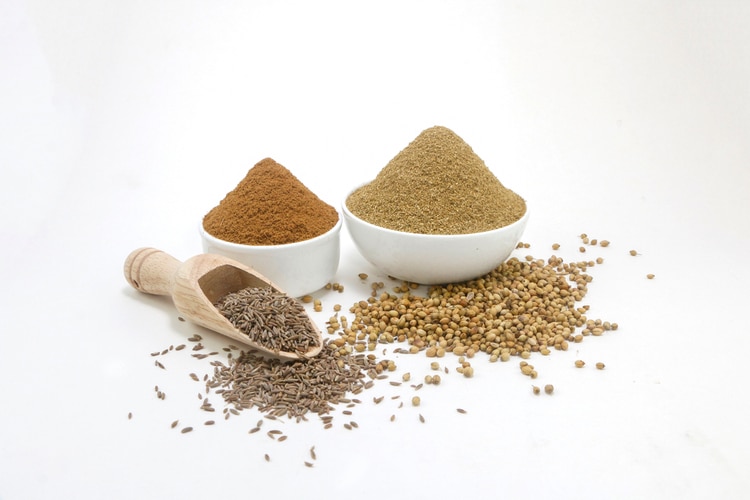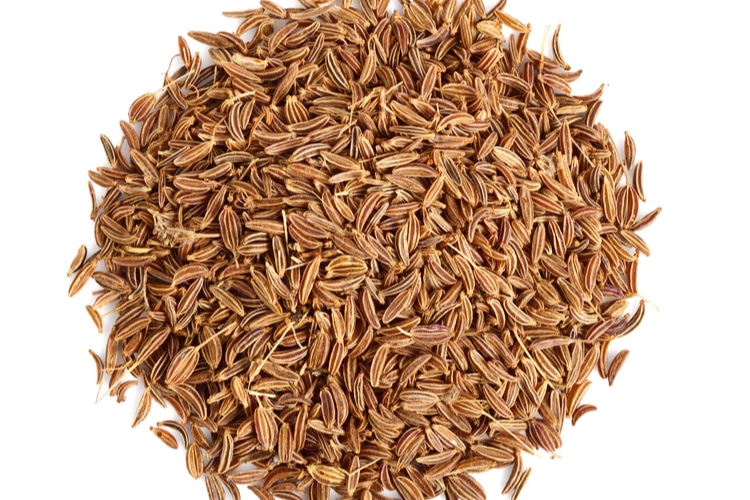Many home chefs have questions about cumin vs. coriander. It’s no surprise, as these two spices work well together and are often used in the same recipes and spice mixes.
Even though these two spices complement each other in many dishes, they are actually very different. Read on to learn more about each one, how they compare to one another, and how to use them effectively when you are cooking.
Difference Between Cumin and Coriander

Cumin and coriander are both spices associated with South-Asian flavors, but they are very different in taste and appearance. In addition to South Asian cuisine, you can find both of these spices heavily used throughout Europe, Africa, Asia, Central America, and South America.
Are Cumin and Coriander the Same?
Cumin and coriander are not the same. These spices come from different plants, have different flavor profiles, and are used in different types of cuisine.
Although they are not the same spice, they have some similarities, including the following:
- Cumin and coriander both have earthy undertones to their flavors
- Cumin and coriander are both used in whole seed or ground forms
- Cumin and coriander are both used in spice mixes, especially in South Asian cuisine
- Cumin and coriander are both readily available worldwide and used in many types of cuisine
The major difference between cumin and coriander is that cumin has a bitter flavor, while coriander has a sweeter taste.
Cumin also brings more heat than coriander, although both have a somewhat earthy tone to their flavors.
Although both spices come from plants in the parsley family, they are actually very different. Here are some of the significant differences between these two spices:
Appearance: Cumin has a thin, brown appearance, while coriander has a lighter, round appearance
Flavor: Cumin has a bitter, nutty taste, while coriander has a sweet, lemony taste
Shelf Life: Cumin seeds will stay fresh for one year, while whole coriander seeds last two to four years.
Nutritional Value: Cumin is the healthiest of all spices, whereas coriander has fewer health benefits.
Heat Level: Cumin brings a heavier heat level, while coriander has a milder heat level.
Use Cases: While both can be used in spice mixes, cumin is more often used in meats and savory dishes, while coriander is found in sweet dishes and desserts.
Cumin vs Coriander Comparison Table
Below is a comparison table of cumin and coriander for reference when cooking with these spices.
| Flavor Profile | Usage | Cuisine | Health Benefits | Appearance | Availability | |
| Cumin | Bitter, nutty, spicy | Usually used in seed form (sometimes ground or toasted) | Middle East, South America, Latin America, Southeast Asia, Africa | Extremely healthy, supports weight management, lowers blood sugar, lowers cholesterol | Thin brown seeds with striped ridge | Readily available |
| Coriander | Sweet, floral, lemon | Can be used in seed form or in mature form (cilantro) | South America, Latin America, Southeast Asia, India | Healthy, improves cardiovascular health, reduces inflammation, lowers blood sugar | Round tan seeds with ridges | Readily available |
Can You Substitute Cumin for Coriander?
You should not substitute cumin for coriander because of the significant difference in the taste of these two spices. Cumin is much more bitter than coriander, so making this substitution can significantly alter the flavor of your spice mix or dish.
Instead, try these common substitutes for coriander:
Caraway seeds
Garam masala
Curry powder
Can You Substitute Coriander for Cumin?
You should not substitute coriander for cumin. As we mentioned above, the different flavors of these spices ensure that making this substitution will alter the taste of your dish.
The taste is one significant difference to be aware of when considering cumin vs. coriander.
Instead, try these common substitutes for cumin:
Caraway seeds
Garam masala
Chili powder
What Is Cumin?

Cumin is made from the dried seeds of Cuminum Cyminum, a flowering plant native to South Asia. This plant is part of the parsley family, resulting in occasional confusion between cumin and other spices in the parsley family, such as coriander or caraway.
Cumin brings intense flavor to a dish, often described as earthy or bitter. It provides smokiness to many dishes, making it a popular choice for chefs looking for bold and lasting flavors.
Cumin originated in South Asia but has since grown in popularity in cuisines worldwide. Cumin is well-known for its health benefits and is often used in medicines and homeopathic remedies.
Cumin is also known for helping people lose weight, lower their blood sugar, and for its high iron content.
This article in Pharmacognosy Reviews found that most of the traditionally accepted medicinal benefits of cumin are accurate and stand up to the test of modern medicinal standards. However, the scientific community is still conducting research to confirm that the spice does have medicinal properties.
In addition to being used to spice up various dishes, cumin can also be made into oils. These versatile oils are used in cooking, perfumes, essential oils, and even cosmetics.
How to Use Cumin
You can use cumin to bring bold spice and a bitter aftertaste when in everyday dishes. It is used for this purpose in complex dishes and simple cooking, especially throughout South and Southeast Asia.
Use cumin and other complimentary spices to create a delicious spice mix. The easiest and most popular way to use cumin is in spice mixes and spice rubs.
Once you make your mix, apply it to different meats or other dishes to add a South-Asia-inspired flavor. While cumin and coriander should not be substituted for one another, they work very well together in spice mixes.
Cumin can also add spice to stews and soups, especially with other complementary spices (such as coriander). Also, consider adding cumin to your gravies for an earthy undertone.
In addition to using dried or ground cumin in spice mixes, you can also toast the whole seeds on the pan to create a pleasant aroma for your dishes (or your kitchen). Roasting them in this way can also give them a more distinct flavor when you cook with them.
What Is Coriander?

Coriander is the seeds of the cilantro plant, another popular staple in many cuisines.
Like cumin, cilantro is a plant in the parsley family. Coriander is native to the region spreading from Southern Europe and North Africa to Southwest Asia.
The plant has become so widespread in the area that it is difficult to know where exactly it originated. However, some scientists point to Portugal or Israel for its origins.
Interestingly, some people taste coriander leaves, also known as cilantro, differently than others. While most taste it as the sweet citrus flavor we have described throughout this article; others have an aversion to the spice that makes it taste “rotten” or “soapy.”
While the reason for this remains unclear, scientists have found some links between a person’s genes and whether or not they enjoy coriander or cilantro.
How to Use Coriander
You can use coriander to add a sweet and citrusy flavor to your dishes. Some describe coriander as lemony, while others prefer orangey, but most agree that it brings a sweet and bold taste to food.
You can use coriander in a spice mix or rub and then use that to season meats, soups, stews, or other dishes. It is a great way to add both earthy and sweet flavor to whatever you are cooking.
As we mentioned earlier, coriander and cumin work well together in most spice mixes and rubs.
Some cuisines use coriander in unique ways that you can emulate at home. In Germany, coriander is a popular addition to sausages of all kinds.
In North America, other cuisines use powdered coriander as a condiment, which they enjoy spread on meat.
You can also use coriander in desserts, where its sweetness fits well. It also brings a citrusy and flowery element to desserts, making it a popular choice in various baked goods and fruit-centric desserts.
Coriander is also popular in non-dessert baked goods, such as rye bread.
You can also use coriander to flavor alcohol. Its citrus taste makes it popular with certain types of beer, such as Belgian wheat beers that are often served with an orange peel. Coriander is also one of the key elements in flavoring gin.
Like cumin, coriander seeds can also be roasted to enhance their aroma and heighten their flavors. Many people enjoy the aroma of roasting coriander seeds both in their foods and in their homes.
Coriander is also used to create essential oils that produce the same scents and feelings.
Another use for coriander seeds is to pickle vegetables. Coriander is a crucial ingredient in pickling recipes worldwide, often made into a spice with complementary spices such as turmeric and curry.
Wrapping Up
Although cumin and coriander are both members of the parsley family, they are significantly different and should not be substituted for one another in cooking. Cumin has a strong bitter taste, while coriander has a milder, sweeter taste.
Despite their differences, cumin and coriander complement one another very well. You can use them together in various spice mixes, rubs, and for many other purposes in the kitchen.






